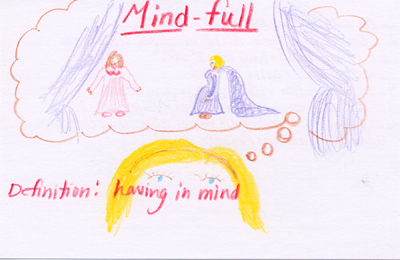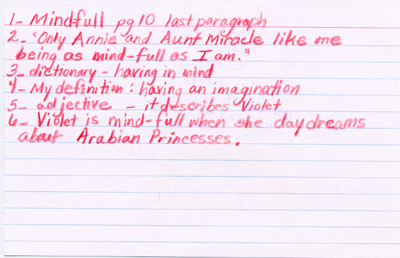
5th grade (6th grade level)
Section One (pgs. 1-22)
Discussion Director
The job of discussion director is to develop a list of questions that your group will discuss about this part of the book. These questions should vary in difficulty and type. You must include 1 Setting, 1 Cause-effect, 1 Character relationship, 1 Problem-solution, and 1 of your choice. Use the list of words below to help you begin your questions.
Begin questions with words like:
Who What When Where
Why How Tell Describe
Questions can be about:
| Setting | Problem/Solution |
| Narrator | Topic |
| Main idea | Cause/Effect |
| Mood | Character Relationships |
| Compare/Contrast |
Setting
1. Where does the story take
place?
a. San Antonio,
Texas
b. Australia
c. Cimarron County,
Oklahoma
d. Sangre de
Cristo Mountains
(Answer c. Pg 1 paragraph 2)
Cause-effect
2. How does the wind and dust
lead Annie to want to be an archaeologist? Explain your answer.
The winds blow the dust around so much that it reveals ancient Indian campgrounds, arrowheads, and spearheads. Annie keeps all the treasures she finds in a shoe box under her bed. She tries to imagine what life was like for the Indians and can learn from the artifacts she finds. (Answer: Pg 3 paragraph 2)
Inference
3. Who is Miniver? How
do you know? Explain.
Miniver is the only cow they have left. Annie talks about how one duster killed all of their chickens and all but one cow. She also talks about how they used to be able to trade their cream and butter, but now they’re lucky if Miniver produces enough for a couple loaves of bread. Only a cow could produce the products needed to make cream and butter. (Answer: Pg. 8 paragraph 2)
Character Relationship
4. Why do you think Violet
felt that she could tell Aunt Miracle her secret about dolls? Explain.
Aunt Miracle was different. She was blind, but yet she knew things about Violet. She noticed that Violet was a sensitive and delicate girl just like her. Violet’s parents didn’t seem to notice this. What Violet did when she blurted out her secret was realize that Aunt Miracle could “see” things that others couldn’t. Aunt Miracle was special and Violet felt her trust. (Answer: Pg. 9)
Problem-solution
5. Why does Aunt Miracle say
that the snakebite kept her in shoes during childhood and gave her the
chance to see some of the world? Explain.
Folks from all around were amazed
that Aunt Miracle survived the snakebite. She appeared in medicine
shows and carnivals from San Antonio to Santa Fe. This means that
people “paid” to see her little finger and her. The money her parents
received from people paying to see her went towards buying her shoes and
clothes and food. By traveling from San Antonio to Santa Fe, she
was able to see a lot of the world.
(Answer: Pg 18 paragraph 1)
Passage Picker
Passage Picker selects significant passages from the sections being read. Determine why it is important and call readers’ attention to the passage. Then lead a discussion about the passage you chose.
Steps of Passage Picker
1. Pick out the passage you would
like to share.
2. Write down the page and paragraph
number.
3. Write down the first two words
and the last two words of your passage.
4. Write down the reason you chose
the passage, and explain why!
5. Ask a question about your passage,
and give an answer.
6. Write down the Author’s Purpose:
To
describe
To Entertain
To Inform
To Persuade
Possible Reasons for Picking a
Passage
| Important | Informative | Interesting |
| Surprising | Controversial | Descriptive |
| Funny/Amusing | Scary/Frightening | Historical |
| Confusing | Entertaining | Persuasive |
| Intriguing | Dialect | Figurative Language |
| Mysterious | Fantasy | Alliteration |
| Element of Folktales | Moral | Theme |
| Scientific | Fact/Opinion | Cause/Effect |
| Problem/Solution | 5 Themes of Geography | |
| Math | Step by Step |
1. Page 19 paragraph 3
“Before
she . . . a storm.”
REASON: I chose this passage
because it describes what dust pneumonia is. I need to know that
so I can understand how these people are dying, and what Aunt Miracle might
be going through.
QUESTION: Why is Violet afraid
that Aunt Miracle has dust pneumonia?
ANSWER: Because she has had
a bad coughing spell and that’s one sign of dust pneumonia.
AUTHOR’S PURPOSE: To describe
and inform the reader.
2. Page 3 paragraph 1
“Mama says . . . dinosaur
spine.”
REASON: This paragraph is
filled with imagery that helps the reader visualize the way the land looks.
It’s also a simile describing the dunes as arms and a metaphor describing
the sand on the fence.
QUESTION: Why does Annie think
it’s pretty there?
ANSWER: She thinks maybe because
it’s the only thing she knows or has known.
AUTHOR’S PURPOSE: To entertain
3. Page 7 paragraph 4
“Don’t you . . . to sleep.”
REASON: I like this paragraph
because it lets me know how Violet really feels. She is sad and kind
of scared. In this paragraph she is calming and reassuring herself
by playing with her dolls and saying words of encouragement through the
dolls. Notice that she plays with the daddy doll to give herself
a sense of security. This helps her to sleep.
QUESTION: How does Violet
feel about her family’s situation? How does she soothe herself?
ANSWER: Violet is scared about
the dust storm. She is afraid of what might happen to her family
because of the dust storm. She soothes herself by playing with her
dolls and letting them say words of encouragement just as her parents would
say to her.
AUTHOR’S PURPOSE: To entertain
4. Page 12 paragraph 2
“My best . . . a book.”
REASON: I love Annie’s description
of Violet. She uses a simile and lots of adjectives. As I read
this passage, I can picture Violet in my mind. I can picture how
she looks. I also get the feeling that I know her. Annie tells
us that Violet wants to be an actress, so I imagine her always acting like
she is somebody else. I see her with a distant look in her eyes.
QUESTION: Name all of the
descriptive words (adjectives) and the object(s) they describe in this
passage.
ANSWER: reddish gold hair,
fast, bright eyes, swift, proud movement, lightening fast mood swings
AUTHOR’S PURPOSE: To describe
(a character)
Word Wizard
The Word Wizard searches the section of text for words that are key to understanding what is happening in the story. He/she notes the page and sentence where the word is found. Then checks the dictionary meaning of the word. They lead a discussion about the meaning and intent of the word from context and what the word contributes to the import of the passage.
Steps for Word Wizard
1. Write down
the word.
2. Copy the sentence
form the book in which the word appears.
3. Look up the
word in the dictionary.
4. Using your
context clues from the sentence and the dictionary definition, write down
in your own words the definition of the word.
5. Write down
the correct part of speech (noun, verb, adjective, adverb).
6. Write down
a question and the answer about the word that would help you to teach the
word that makes your group refer back to the text, OR write a sentence
using the word wizard word.
7. Make your
word wizard card. Be sure to include in big print your word and the
page and paragraph number. On the other side of your card should
be a picture, the word, and the definition of the word.
Examples of words you may look
for:
| Compound | Word Families |
| Contractions | Capital Letters |
| Punctuation | Letter hunt: lower case |
| New Strange | upper case |
| Hard | Describing |
| Short Vowels/Long Vowels | Funny |
| Important | Bold |
| Synonyms/Antonyms | Quotes |
| Possessives | Italics |
Word One:
1. Kneaded pg 1 paragraph 1
2. "I was fixed on her apron, fussing ot be picked up while she
kneaded the dough."
3. Dictionary: to work (dough, clay, etc.) into a pliable
mass by pressing and squeezing.
4. My definition: When a person uses their hands to mash
the dough into a form that will bake into bread.
5. verb
6. I have seen my grandmother knead dough when she makes bread.
7. Make card.
Word Two:


Word Three:


Word Four:
1. Ravage pg 13 paragraph 1
2. "Either it had to grow fierce or die, and since it didn't
die, it's as strong as the storms that ravage our farms."
3. Dictionary: to destroy violently; devastate
4. My definition: to ruin.
5. verb
6. What are characteristics of the storm that ravaged the farms?
Answer: Lots of wind, dust, more wind that ripped things apart,
and carried things away, and dryness.
7. Make card.
Character Sketcher
The job of the character sketcher is to find an interesting character from the section. You will then find three words that describe the character. For each word, or character trait, you will give the proof, or example. Tell why you know this character has this trait.
The next thing you will do is to tell one of your character’s goals, or what the character wants to do in that chapter(s).
Then you will find one of the character’s problems in that chapter(s) and the solution or possible solution to the problem.
Finally, you get to have fun and illustrate your character.
Have fun!
Your job is to create a character sketch of Violet Cobble. See example below.

Investigator
The job of investigator is to dig up some background information on any topic related to your book. This might include:
The geography, weather, culture, or history of the book's setting.
Information about the author, her/his like, and other works.
Information about the time period portrayed in the book.
Pictures, objects, or materials that illustrate elements of the book.
The history and derivation of words or names used in the book.
Music that reflects the book or the time.
The idea is to find one bit of information or material that helps your group understand the book better. Investigate something that really interest you--something that struck you as puzzling or curious while you were reading.
Ways of gathering information:
The introduction, preface, or "about the author" seciton of the book.
Library books and magazines.
On-line computer search and encyclopedia.
Interviews with people who know the topic.
Other novels, nonfiction, or textbooks you've read.
For this investigator role: I would like for my students to research the Great Depression and the Dust Bowl. I just want you to get an idea of what they were like, how people lived, and why they occurred. Below is a list of resources I would provide for my students. I believe that providing a fair amount of resources so that they will not have to leave the room to do their research. However, if they like they can stay after school to do more research in the library.
Books
Meltzer, Milton. Great Journeys: Driven from the Land:
The Story of the Dust Bowl. Marshall Cavendish, New York:
Benchmark Books, 2000.
Wroble, Lisa A. Kids During the Great Depression.
Encyclopedias
Internet
www.pbs.org/wgbh/amex/dustbowl/
Music
Marches form the 20's
Big Band music
"Madame Butterfly," the opera
* Note: You should discuss copyright laws with the students so that they site where their information came from.